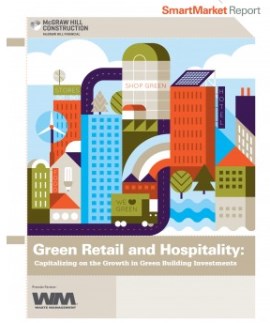
by Shane Henson — July 8, 2013—Consumers can expect to see more retail and hotel establishments that are sustainable built in the years to come given the growing interest owners of these types of establishments have shown in green building, according to a new report released this week by McGraw Hill Construction in partnership with Waste Management.
The report, Green Retail and Hospitality SmartMarket Report: Capitalizing on the Growth in Green Building Investments, is based on a study of 79 retail, 30 hotel and 22 restaurant owners conducted in 2013 by McGraw Hill Construction.
The study defined a green building project as one built to (LEED) Leadership in Energy & Environmental Design or another recognized green building standard, or one that is energy efficient, water efficient, and improves indoor air quality and/or engages in material resource conservation.
Notably, by this definition, the percentage of retail owners that have taken a green approach in over half of their building projects rose from 18% in 2011 to 38% this year, and is expected to rise to 52% by 2015. Hotel owners show an even greater investment in green building—the percentage of those owners that have taken a green approach in over half of their building projects rose from 28% in 2011 to 48% in 2013, and is projected to rise to 64% by 2015.
According to the study, owners are also committing to green operations and maintenance (O&M) practices, with nearly two-thirds (65%) of retail owners reporting high green O&M activity, and an even stronger 73% of hotel owners reporting the same.
Owners note strong business benefits from green building investments and green O&M practices, helping to drive this growth. Most notably, they report the following when comparing the performance of their green buildings to traditional buildings:
- Annual operating cost reductions: Reported by 66% of retail owners (at an average reduction of 8%) and by 51% of hotel owners (at an average reduction of 1%);
- Energy use reductions: Reported by 58% of retail owners and 67% of hotel owners at an average reduction of 15% for both;
- Asset value increases: Reported by 61% of retail owners (at an average increase of 7%) and by 71% of hotel owners (at an average reduction of 11%); and
- ROI increases: Reported by 67% of retail owners (at an average increase of 8%) and by 85% of hotel owners (at an average reduction of 14%).
Per the study, there are many factors driving these owners toward adoption of green building investments and practices. While operating cost reductions are the most highly reported reason for going green (by 66% of retail owners and 73% of hotel owners), there are several other factors considered highly important in their decision-making process such as utility rebates, protecting/enhancing brand, and improving ROI.
However, business factors alone do not account for the increasing commitment to green building. Some 44% of retail owners and 50% of hotel owners find that human impact benefits have also been an important factor in encouraging their decision to invest in green building projects. A full 70% of retail owners see meeting government regulations and standards as a key factor in their decision to do green projects in the future, and 70% of hotel owners consider water use reduction an important factor in that decision. In addition, over half in both sectors report that improved environmental health and well-being has a strong impact on their decision to make future green investments.




